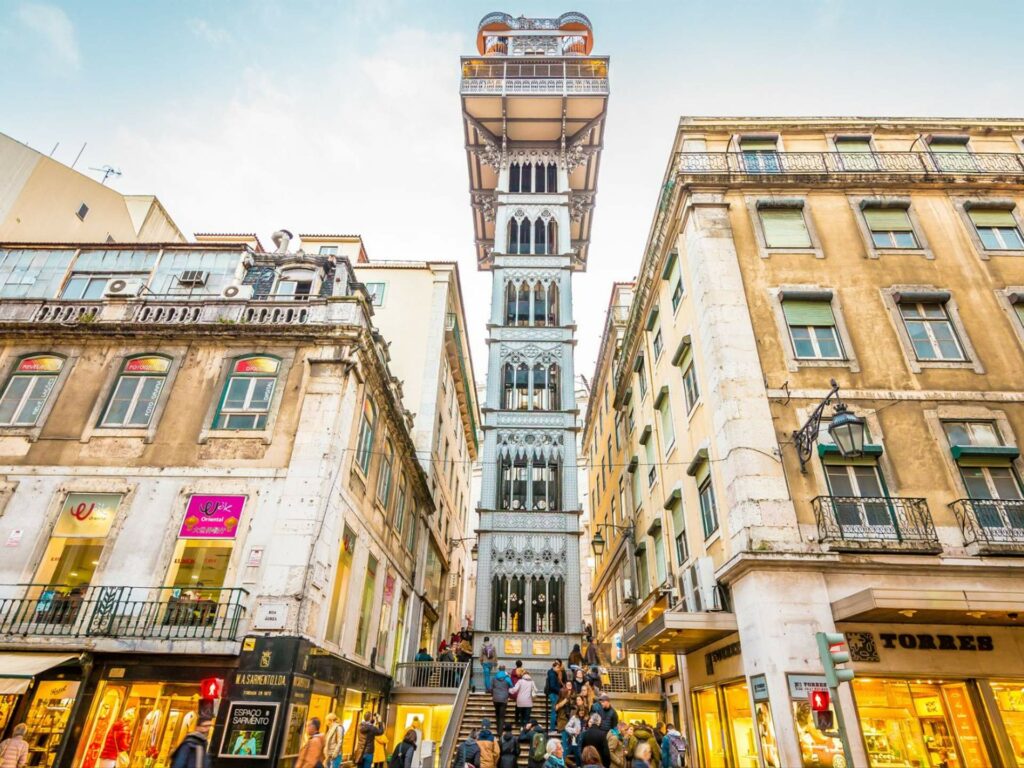Santa Justa Lift, Lisbon: Bridging Past and Present in a Vertical Voyage

Introduction:
In the heart of Lisbon, Portugal, the Santa Justa Lift, also known as the Elevador de Santa Justa, stands as an iconic landmark that transcends mere functionality. This ornate iron structure is not just an elevator; it is a testament to Lisbon’s architectural prowess, historical richness, and a vertical voyage that offers breathtaking panoramic views of the city. This comprehensive exploration invites you to ascend the spiraling journey of the Santa Justa Lift, discovering its historical roots, intricate design, and the cultural significance it holds in Lisbon’s urban tapestry.
Historical Roots:
19th-Century Engineering Marvel: The Santa Justa Lift was conceived in the late 19th century during a period of urban renewal in Lisbon. The city was undergoing significant transformations, and the idea behind the lift was to connect the lower streets of the Baixa district to the higher Carmo Square. It was initially designed by Raul Mesnier de Ponsard, a Portuguese engineer, and disciple of Gustave Eiffel, the renowned French engineer behind the Eiffel Tower.
Iron Elegance and Gothic Influences: Completed in 1902, the Santa Justa Lift is characterized by its iron lattice structure, an elegant example of the prevailing architectural style of the time – the Romantic Iron architecture. The design seamlessly blends function and form, showcasing intricate details and decorative elements that draw inspiration from Gothic aesthetics. The lift is not merely a practical solution but a work of art that enriches the city’s skyline.
Architectural Marvels:
Iron Lattice Elegance: The Santa Justa Lift’s most striking feature is its iron lattice structure, resembling a giant wrought-iron filigree. As visitors approach, they are greeted by the intricate geometric patterns and delicate arches that contribute to the lift’s overall elegance. The choice of iron not only reflects the engineering ingenuity of the time but also adds a touch of industrial charm to the urban landscape.
Neogothic Influence: The Neogothic influences in the design are evident in the arches, tracery, and decorative motifs that adorn the Santa Justa Lift. The filigree work, reminiscent of Gothic cathedrals, creates a visual link to Lisbon’s architectural history while adding a touch of romanticism to this functional structure.
Carriage and Observation Deck: The lift’s original wooden carriage, adorned with polished brass, remains an integral part of the experience. As the lift ascends, passengers are treated to a captivating view of Lisbon’s vibrant neighborhoods. At the top, an observation deck offers panoramic vistas of the city, including landmarks like the São Jorge Castle, the Tagus River, and the Baixa district.
Cultural Significance:
Urban Connectivity: Beyond its functional role, the Santa Justa Lift plays a crucial role in connecting Lisbon’s neighborhoods. It serves as a vertical link between the bustling streets of Baixa and the elevated Carmo Square, providing a convenient and scenic route for locals and tourists alike.
Tourist Attraction: Over the years, the Santa Justa Lift has evolved into a must-visit tourist attraction. Its unique blend of historical charm and breathtaking views attracts visitors from around the world. The lift has become a symbol of Lisbon’s urban identity and a point of reference for those exploring the city’s historic center.
Night Illumination: As night falls, the Santa Justa Lift transforms into a glowing beacon against the Lisbon skyline. The delicate ironwork is illuminated, casting a warm glow that adds to the city’s nocturnal charm. The lift becomes a central element in Lisbon’s evening ambiance, inviting admiration from both residents and nocturnal wanderers.
Practical Tips:
- Avoid Peak Hours: To enjoy a more leisurely experience, consider visiting the Santa Justa Lift during non-peak hours to avoid long queues.
- Combine with Other Landmarks: Since the lift is located in the heart of Lisbon, take advantage of its central location and combine your visit with nearby landmarks such as the Carmo Convent and the bustling Baixa district.
- Sunset Experience: For a magical experience, plan your visit around sunset to witness the changing hues of the Lisbon skyline from the lift’s observation deck.
- Photography Opportunities: The Santa Justa Lift provides excellent photography opportunities, especially during the golden hours of sunrise and sunset. Capture the intricate ironwork against the changing sky for stunning visual compositions.
Conclusion: A Vertical Symphony in Iron
In conclusion, the Santa Justa Lift stands as a vertical symphony in iron, harmonizing historical elegance with modern urban connectivity. This remarkable structure, born out of 19th-century engineering vision, continues to enchant visitors with its Gothic-inspired details and panoramic views. The Santa Justa Lift is not merely an elevator; it is a journey through time and space, inviting all who ascend to experience the beauty of Lisbon from new heights. As the iron lattice gracefully reaches towards the sky, it bridges the past and present, offering a unique perspective on Lisbon’s architectural, cultural, and historical tapestry.




